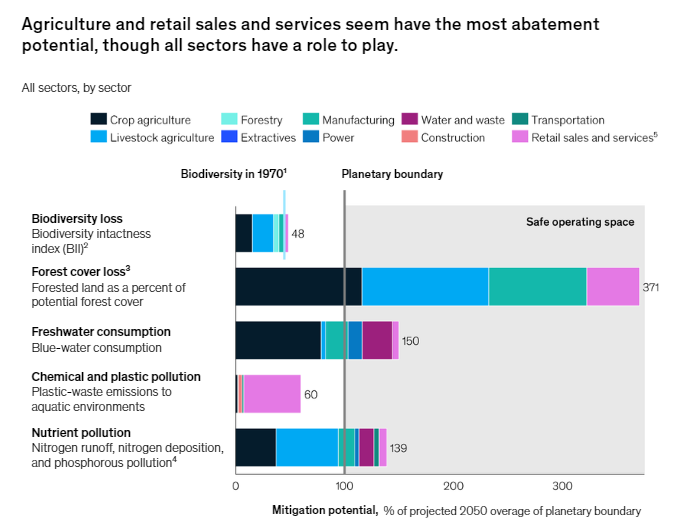
How firms can contribute to restoring the world’s natural capital by 2050
Corporate ESG efforts could provide $2.3t in economic benefits by 2030, according to McKinsey.
McKinsey & Company’s study titled "Nature in the balance: What companies can do to restore natural capital" argues that corporate action could potentially help the world return to safe levels in three of the planetary boundaries: forest cover loss, freshwater consumption, and nutrient pollution.
According to the study, corporate action could also address 48% of the projected overage of the boundary for biodiversity and 60% of the identified boundary for chemical and plastic pollution.
The research assesses the effect of 47 potential corporate actions across five planetary boundaries: biodiversity loss, forest cover loss, freshwater consumption, chemical and plastic pollution, and nutrient pollution. The study notes that many of these actions could provide positive returns on investment and could be implemented using existing technologies.

However, the study also cautions that the potential for corporate action to make a difference will only be realised if policymakers and other stakeholders create enabling conditions for these actions to be taken. This will require collaboration and coordination among a wide range of stakeholders, including governments, businesses, and civil society organizations.
Corporate action alone is not sufficient to address these challenges and "whole of society" levers, such as nature conservation and consumer dietary shifts, as well as new technologies, will be necessary to close the remaining gaps.
A look into the sectors
Whilst the agriculture sector is the largest contributor to natural capital depletion, accounting for 52% of the total impact, it also has the greatest potential to address projected overages in biodiversity, freshwater, and nutrient planetary boundaries by 2050.
The retail sales and services sector was found to be the second largest contributor, accounting for 27% of the impact, whilst the power sector was the third largest contributor, accounting for 21% of the impact.
The study found that agriculture levers could address 72% of the total identified improvement in biodiversity loss, addressing 35% of the global overage in 2050.
In addition, the study found that agriculture could bring the world within the planetary boundary for forest cover loss, address 82% of the gap to the freshwater consumption boundary, and meet 94% of the gap for nutrient pollution in 2050.
Eight levers, if fully implemented, could have the largest impact in addressing the agriculture sector’s impacts on nature. These levers include conservation agriculture, precision fertilization, improved livestock production, and more efficient irrigation systems.
Guide for corporations
McKinsey & Company provided four steps that could help companies find ways to contribute to nature.
First, companies can assess their nature footprint—that is, the types, magnitude, and materiality of their impacts and dependencies on nature. Before defining a nature strategy, companies would need transparency to ensure they can mitigate risks, address impacts on natural capital, and identify business opportunities. Companies can select metrics that broadly address impacts across their footprints from numerous indicators that are already available.
Second, companies can identify which of their activities have the potential to both reduce impacts on nature and improve company performance. For each potential company-specific lever, companies can determine the abatement potential, how long it would take to have impact, sources of financing, and possible returns, among other factors. The “mitigation hierarchy”—an international framework from the World Bank’s International Finance Corporation—could provide guidance on the priority order of actions to take.
Third, companies could set initial targets for nature and levels of commitment, define a set of actions, and integrate them into a broader portfolio of initiatives. Companies may look to organizations such as the Science Based Targets Network (SBTN) for guidance on how to set time-bound, science-based, and quantitative targets in line with the planetary boundaries. They could create a portfolio of initiatives that includes implementing abatement levers and potentially investing in nature or biodiversity credits.
Fourth, companies can closely monitor progress against their goals and may prepare to disclose their progress. Various organizations are working to develop standardized voluntary reporting metrics, and the Taskforce on Nature-related Financial Disclosures (TNFD) has developed detailed guidance across four pillars of disclosure: governance, strategy, risk management, and metrics and targets.












